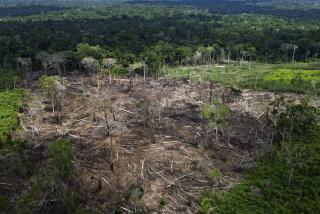U.S., 5 other nations open wallets for forests
Reporting from Copenhagen — Signaling a breakthrough on a key climate change issue, the United States and five other nations Wednesday pledged $3.5 billion over three years to preserve the world’s forests.
“Protecting the world’s tropical rain forest is not a luxury, it is a necessity,” Agriculture Secretary Thomas Vilsack said, noting that deforestation accounts for 17% of humanity’s emissions of heat-trapping greenhouse gases. The U.S. said it would contribute $1 billion through 2012.
As a comprehensive agreement in Copenhagen remains elusive, negotiators this week nonetheless reached a tentative consensus on rules to preserve forests, including verification measures, the need to protect biodiversity, and the recognition of indigenous peoples’ rights.
Tropical nations have refused to commit to a timetable to halt deforestation unless wealthy countries agree on long-term multibillion-dollar funding for the effort.
To slow deforestation 25% by 2015 would require $20 billion to $35 billion per year, according to scientists and economists.
The pledges Wednesday build on the $1 billion that Norway pledged in 2008, which it has begun spending in the Amazon. With additional offers from Australia, France, Japan and Britain, the pledges reach $3.5 billion, far short of the $10 billion sought by tropical nations and conservationists.
“It’s a start, but we’ll need a lot more,” said Gov. Eduardo Braga of the heavily forested state of Amazonas, Brazil, which is four times the size of California.
“Industrial nations are responsible for most of the emissions in the atmosphere. They owe us a debt,” Braga said.
Under cap-and-trade programs, including one pending in the U.S. Congress and another under consideration in California, rain forest protection could be funded in part by utilities, refineries and other companies as a substitute for reducing their own emissions.
The 1997 Kyoto Protocol, the current climate treaty, failed to include deforestation, in part because of doubts that forest preservation could technically be measured -- an issue now largely manageable by improved satellite technology.
But in the meantime, about 300 million acres of forests have been lost. Conversion to cattle ranches, due to a global rise in the appetite for beef, fueled much of the destruction. Logging operations, soybean farms, palm oil plantations and slash-and-burn agriculture by poverty-stricken residents are also major causes.
Behind China and the United States, Indonesia and Brazil are the third- and fourth-largest emitters because of wide-scale cutting and burning of forests, which releases carbon dioxide.
Money to preserve forests under a climate treaty could be funneled into incentives for sustainable logging and for intensive agriculture so less forest would need to be cleared. Pilot projects are promoting alternative economic activities, such as nut harvesting and rubber tapping, which do not harm trees.
Rain forest funding would also help to monitor forests with satellites and send police to remote areas to halt illegal logging.
In remarks before a group of conservationists, business executives and government leaders Wednesday, Norwegian Prime Minister Jens Stoltenberg argued that saving rain forests is the cheapest and fastest way to slash emissions.
“We don’t have to develop new technology,” he said. “We can just stop doing something that is destroying the environment of the Earth.”
But negotiators for industrial nations have balked at a proposal to provide long-term financing of $10 billion a year, said President Bharrat Jagdeo of Guyana.
“We don’t want a free lunch,” he said. “We want payments based on performance.”
Beyond the tropical forest initiative, Vilsack pledged that the Obama administration would also focus on saving U.S. forests. This week, he said, the U.S. Forest Service will announce a program to manage public forests for “climate mitigation” in addition to water conservation and other environmental benefits.
The Tongass National Forest in Alaska, he noted, covers 2% of the U.S. landmass, but stores as much as 8% of its carbon. Roadless areas, a source of controversy during the Clinton and George W. Bush administrations, “are also critical in conserving and storing carbon,” he said.
margot.roosevelt @latimes.com
More to Read
Sign up for Essential California
The most important California stories and recommendations in your inbox every morning.
You may occasionally receive promotional content from the Los Angeles Times.











